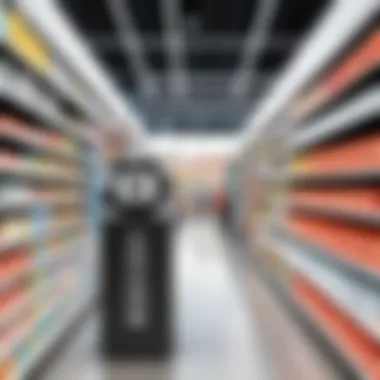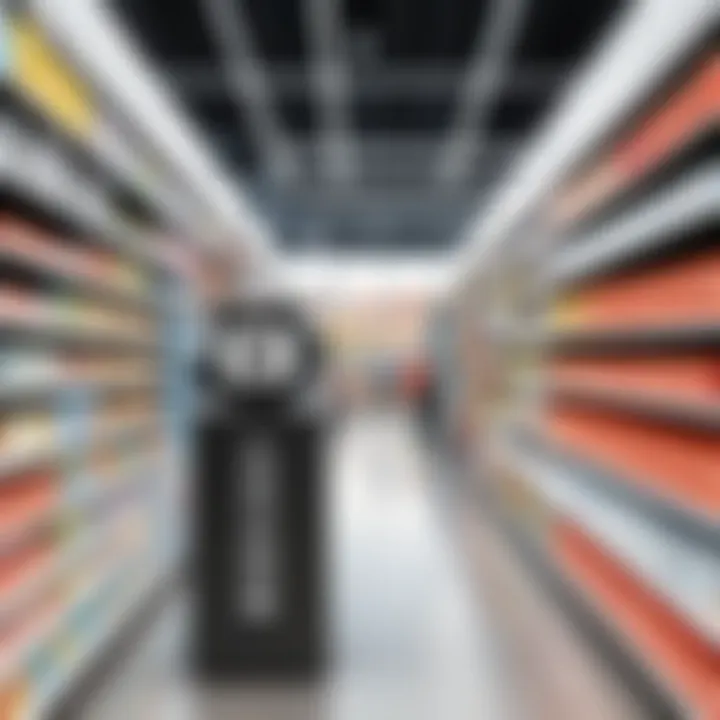Exploring Barcode POS Systems in Retail Efficiency


Intro
In the fast-paced world of retail, barcode point-of-sale (POS) systems are akin to the grease that keeps the wheels turning smoothly. These systems not only enhance operational efficiency but also maintain an acurate inventory—essential for any retailer. As we navigate through the intricate landscape of barcode POS systems, it's vital to understand the foundational elements that underpin its functionality and technological evolution.
From grasping the basic mechanics of how barcodes work to realizing the profound impact of integrated software solutions, this article shall serve as a comprehensive guide for IT professionals, cybersecurity experts, and students keen on diving deeper into this subject.
Understanding the Basics of Barcode Technology
What is a Barcode?
A barcode is a visual representation of data that consists of varying widths and spacing of parallel lines or a pattern of dots. It's like a secret code that when scanned, reveals crucial information about a product. Scanning devices translate this code into human-readable details, typically a product's price and stock level.
Key Components of a Barcode System
- Barcode Scanner: This device reads the barcode and converts it into a number or information that can be further processed.
- POS Software: This is the backend that manages transactions and store data, integrating sales data in real-time.
- Database: A comprehensive repository that holds information relating to products, customers, and transactions.
Understanding these core components is essential. They must all work harmoniously to create a system that is not only efficient but also adaptable to the fast-changing retail environment.
Overview of Barcode Technology's Evolution
Barcodes have come a long way since their inception. Once limited to just basic product identification, they have now evolved to incorporate complex data tracking and real-time inventory updates. With the advent of QR codes and mobile scanning methods, the versatility of barcodes has multiplied, making them an indispensable tool in modern retail.
"In today's retail transactions, speed and efficiency are non-negotiable. Barcode POS systems ensure you’re not just keeping up but staying ahead of the competition."
Advantages of Barcode POS Systems
The integration of barcode technology into POS systems brings forth manifold advantages. Its operational benefits include speed during checkout, accuracy in inventory management, and real-time data integration, enabling retailers to make well-informed decisions.
Impact on Inventory Management
Managing inventory can sometimes feel like navigating a labyrinth. However, with barcode systems, retailers can streamline this process significantly. Here’s how:
- Automated Data Entry: Minimizing human errors related to manual entry of product data.
- Real-time Tracking: Instant access to stock levels can help prevent loss and overstocking situations.
- Sales Analytics: Gaining insights into purchasing trends, enabling better stock management.
Thus, embracing barcode POS systems is not merely about tech adoption—it’s about enhancing the entire operational framework of a retail business.
Future Prospects in Retail with Barcode Technology
As we look ahead, barcode technology continues to adapt and grow, especially in the realms of automation and artificial intelligence. Future iterations of barcode POS systems may interweave predictive analytics, allowing retailers to forecast inventory needs more accurately. This would not only boost customer satisfaction but would foster improved relations with suppliers and distributors.
Throughout this exploration of barcode POS systems, we’ve unraveled its importance and the dynamic interplay of technology that brings it to life. The aim is to understand how these systems revolutionize retail processes, creating an environment that champions efficiency and innovation.
Understanding Barcode POS Systems
In today's fast-paced retail environment, understanding the intricacies of barcode POS systems is crucial for businesses aiming to excel. This technology not only streamlines operations but also dramatically enhances accuracy within inventory management. For retailers, these systems serve as the backbone of transactional efficiency, bringing together hardware, software, and processes that facilitate smooth business operations.
Defining a POS System
A Point of Sale (POS) system is much more than just a cash register at the checkout counter. It is an integrated suite of tools that allows businesses to manage transactions, track sales, and analyze customer behavior. In simplest terms, it's where the magic happens—the point where a customer completes their purchase.
The components of a modern POS system typically include a computer or tablet, software to manage transactions, and often hardware such as barcode scanners, cash drawers, and receipt printers. This amalgamation enables retailers to efficiently handle everything from sales to inventory management.
The Role of Barcodes in Retail
Barcodes are like the secret sauce in the recipe of retail operations. They transform the cumbersome task of manual entry into a swift, error-free process. Each barcode represents a unique identifier for individual products, allowing for quick scanning and processing at the checkout.
Barcodes enhance the efficiency of POS systems in several ways:
- Speed: Scanning a barcode takes mere seconds compared to manually entering product information.
- Accuracy: Minimizing human error is vital. With barcodes, the likelihood of mistakes drops significantly.
- Data Capture: Barcodes facilitate easy data collection on inventory levels and sales, further impacting business decisions.
Furthermore, as the retail landscape continues to evolve, the role of barcodes remains pivotal, aligning well with trends toward automation and data analytics in the industry. As retailers embrace technology, understanding the significance of barcodes becomes essential in navigating the complexities of modern retail.
Components of a Barcode POS System
When it comes to barcode point-of-sale systems, understanding their components is crucial. A barcode POS system is not just a cash register; it's a finely tuned machine comprised of various hardware and software elements that work in tandem to streamline retail operations. Each component plays a unique role in enhancing efficiency, improving accuracy, and offering a seamless customer experience. From the hardware that handles transactions to the software that manages inventory, grasping the full picture allows retailers to make informed decisions that boost productivity and sales.
Hardware Essentials
Barcode Scanners
One of the foundational elements of a barcode POS system is the barcode scanner. This device reads the barcodes printed on products, translating them into a format that the POS software can understand. Its role is vital, ensuring that products are identified quickly and accurately. A key characteristic of modern barcode scanners is their ability to work with various barcode formats, from standard UPC codes to QR codes, enhancing flexibility for retailers and improving inventory management.
The unique feature of barcode scanners is the speed at which they operate. Scanners can process a product in mere seconds, drastically reducing the time spent at the checkout. This is particularly advantageous in high-traffic retail environments where every second counts. However, there can be downsides; for instance, older models may have trouble reading damaged barcodes or require specific lighting conditions for optimal performance.
POS Terminals
Next up is the POS terminal, which serves as the hub of the sales transaction. This is where cashiers input sales data, process payments, and retrieve sales reports. A key characteristic of POS terminals is their integration capabilities; they often connect to both hardware peripherals like barcode scanners and software solutions for managing sales data. Retailers benefit greatly from this integration, as it allows for a cohesive transaction experience.
Something that sets modern POS terminals apart is their touchscreen interface. This technology makes the user experience far more intuitive, allowing cashiers to navigate through options easily. Yet, it's worth mentioning that touchscreen terminals can be prone to wear and tear over time compared to traditional button-based systems.
Receipt Printers


To round out the hardware essentials, let’s talk about receipt printers. These devices are responsible for generating paper receipts that document each transaction. This is crucial for record-keeping. A standout feature of many receipt printers is their capacity for auto-cutting, which enhances efficiency by automatically slicing the receipt after printing.
Adding to their utility, modern receipt printers often have the ability to print barcodes and QR codes on receipts, which can be employed for returns or loyalty programs. On the flip side, one limitation is that some printers can only use specific types of paper, which may raise ongoing costs. Still, their importance in ensuring transaction transparency and supporting customer retention strategies can't be overstated.
Software Solutions
The hardware would be ineffective without its software counterpart. The interplay between these technologies defines the overall efficacy of a barcode POS system.
Inventory Management Software
Inventory management software acts as the backbone of any retail operation. It regulates stock levels, tracks product movement, and assists in forecasting demand. The key characteristic of this software is its real-time tracking capability, which allows retailers to see stock levels at a glance. This is immensely valuable as it helps prevent stockouts or overstock situations.
What sets sophisticated inventory management software apart is its data analytics features. This enhances decision-making by offering insights into sales trends and inventory turnover rates. However, such advanced capabilities often come at a higher price point, which could be a consideration for smaller retailers who might not have the budget.
Sales Tracking Applications
Sales tracking applications complement inventory management by providing valuable insights into sales performances. They gather data from each transaction, enabling businesses to analyze sales patterns and customer behavior. A vital characteristic here is the ability to generate detailed reports, which can help retailers identify best-selling items or underperformers.
Unique to many of these applications is their cloud integration, allowing data access from anywhere, as long as there’s internet connectivity. This is particularly beneficial for owners who want to monitor their business on-the-go. However, reliance on internet access does introduce a vulnerability; any downtime can disrupt operations.
In summary, a solid understanding of the components of a barcode POS system reveals their significant role in elevating retail efficiency. From hardware like barcode scanners, POS terminals, and receipt printers to software-driven inventory management and sales tracking solutions, each element contributes to the smooth operation of a retail establishment.
How Barcode POS Systems Function
Understanding how barcode POS systems function is crucial for grasping their impact on the retail landscape. This section delves into two fundamental processes that empower these systems: the scanning process and subsequent data processing and storage. Both of these elements are pivotal in ensuring accuracy, speed, and efficiency in retail transactions, which ultimately translates to improved customer satisfaction.
Scanning Process Overview
The scanning process is the very first interaction customers have with a barcode POS system. Imagine standing at the checkout line with a cart full of items, and the cashier swiftly scans each product. This action sets in motion a cascade of responses within the POS system that is both fast and seamless. Notably, the scanner converts the barcode into readable data, resulting in several key benefits:
- Speed: The quick scanning capability drastically reduces wait times, making the checkout experience smoother for customers.
- Accuracy: Utilizing barcodes minimizes human error, ensuring that the right prices and product information are recorded.
- Efficiency: The technology streamlines the workflow for the cashier, allowing them to handle more transactions in less time.
Different types of barcode scanners are utilized depending on the retail setting. For high-volume environments, laser scanners work brilliantly due to their speed. Conversely, handheld scanners might be favored in smaller stores or warehouses where mobility is key. Whatever the choice, the scanning process is foundational in linking the physical product to its digital counterpart in the inventory system.
Data Processing and Storage
Once a product is scanned, data processing kicks in. This stage is where the barcode POS system shines, transforming simple scans into actionable insights. The journey of data processing involves:
- Capture: The system captures real-time data from the scanned product, including pricing, inventory levels, and sales information.
- Integration: This data is integrated with inventory management systems to update stock levels, potentially triggering reorder processes.
- Analysis: Information gathered doesn’t just stay as raw data. It undergoes analysis to help retailers understand purchasing trends, peak traffic hours, and customer preferences. This insight can inform future business decisions.
Furthermore, data storage solutions connected to barcode POS systems vary based on retail needs. Some systems might make use of cloud storage, ensuring accessibility and the capability to backtrack sales data without a hitch. Traditional on-premises servers can also play a role, especially in environments that prioritize security control.
This integration of scanning, processing, and data storage forms a holistic approach that highlights the importance of information management in retail.
In summation, the functionality of barcode POS systems is not merely about scanning items. The intricate processes of data capture, integration, and analysis work together harmoniously to enhance operational efficiency and generate valuable insights. Retailers who embrace these technologies are better equipped to meet consumer needs while optimizing their inventory management strategies.
Benefits of Implementing a Barcode POS System
Implementing a barcode point-of-sale (POS) system holds considerable importance in today’s retail landscape. With increasing competition and consumer expectations for quick service, businesses must invest in solutions that provide efficiency and accuracy. In doing so, the benefits of a barcode POS system encompass improvements in operations, inventory management, and customer interactions.
Enhanced Operational Efficiency
A barcode POS system streamlines the checkout process, significantly reducing the time taken for transactions. When a customer is checking out, staff can simply scan products instead of manually typing in each item. This shift not only speeds up the process but also minimizes the risk of human error. For instance, instead of fumbling with the price entries or product codes, a quick scan can provide instant information about the product, leaving more time for customer engagement.
Furthermore, these systems allow real-time data entry into inventory management software, updating stock levels instantaneously. As goods are sold, quantities in the system automatically adjust, ensuring more accurate stock levels. Businesses can respond more promptly to fluctuations in demand, avoiding the common pitfall of overstocking or running out of popular items. By automating daily tasks, less time is spent on manual input, leaving staff free to focus on improving service quality.
Improved Inventory Accuracy
Fighting inventory inaccuracy can often feel like chasing shadows. With a barcode POS system, this struggle can come to an end. Utilizing barcode scanners not only expedites the input process but aligns digital inventory counts with the physical goods available. This level of accuracy helps prevent discrepancies that often lead to financial losses.
The benefits extend beyond just preventing losses; they also promote better stock management practices. Retailers can employ analytical tools to review sales patterns and make informed decisions about restocking. For example, if certain items sell quickly while others lag, businesses can adjust purchasing strategies accordingly. This data-driven approach cultivates a more responsive inventory strategy, adapting to consumer needs over time.
Streamlined Customer Experience
The customer experience is pivotal in retail, and this is where barcode POS systems shine. Fewer errors at checkout, shorter waiting times, and well-informed staff all contribute to happier customers. When each interaction at the POS becomes quick and accurate, consumer satisfaction naturally rises. Shoppers are more likely to return to a store where they experienced seamless transactions.
Moreover, a barcode system often integrates with loyalty programs, enabling easier tracking of customer purchases and preferences. Retailers can provide tailored offers based on previous shopping habits, thus creating a personalized shopping experience. Consider a scenario where a customer frequently buys organic products. The POS system can trigger specific promotions for those items, encouraging loyalty and increasing the likelihood of repeat business.
"Adopting a barcode POS system is not just about efficiency; it’s about adapting to modern retail standards and expectations."
In summary, implementing a barcode POS system presents numerous advantages, from boosting operational efficiency to enhancing inventory accuracy and optimizing customer experience. Companies that adapt to these systems position themselves better within a competitive marketplace, catering to consumer demand with finesse and agility. By investing in such technology, retailers can focus on what truly matter—their customers.
Challenges Associated with Barcode POS Systems
In the pursuit of enhanced productivity and better customer service, retailers increasingly turn to barcode POS systems. While these systems hold considerable advantages, they aren’t without their fair share of hurdles that can impact their effectiveness. Understanding these challenges is essential for organizations aiming to implement or upgrade their systems. From technical constraints to integration complexities, each issue demands careful consideration to truly harness the benefits of barcode technology.
Technical Limitations
Technical limitations often surface as the first line of contention for businesses adopting barcode POS systems. A common issue is the variability in barcode quality, which can cause scanning problems. Low-resolution printing or damage can lead to misreads, resulting in delays and inaccuracies in transactions. Retailers must ensure high-quality barcodes are consistently produced and maintained across inventory.
Furthermore, the scanning equipment must be able to handle different types of barcodes. For instance, while a traditional 1D barcode is generally standard, the rise of 2D barcodes like QR codes brings new challenges. Some older systems can't read these newer formats, necessitating an upgrade of both hardware and software.


As technology evolves, keeping systems updated can be a challenge, too. New software versions or security updates may conflict with older systems, sometimes leading to outages or diminished functionality. Retailers must weigh the cost and complexity of regular system upgrades against the risks of falling behind.
Integration Issues
Integration issues often arise when barcode POS systems are expected to work harmoniously with existing infrastructure. Many retailers operate legacy systems that were not designed with modern POS in mind. When trying to link a barcode POS to these older systems, significant compatibility issues can emerge, dragging down overall efficiency and requiring additional resources to resolve.
Moreover, when integrating with e-commerce platforms, challenges intensify. The data needs to synchronize seamlessly across both physical and online stores to maintain accurate inventory levels. Failure to achieve this integration can lead to overselling, stock shortages, and ultimately frustration for customers.
A report from the National Retail Federation emphasizes the need for compatibility between various retail technologies, stressing that improper integration not only stalls operational processes but can also severely impact customer satisfaction.
"In today's retail climate, having a solid technological backbone is no longer a luxury; it's a necessity."
To mitigate these issues, thorough testing during the implementation phase is crucial. Retailers must prioritize solutions that boast strong integration capabilities, ensuring a smoother transition. Regular audits and updates might also help illuminate potential issues early, enabling companies to address integration hiccups while they’re still manageable.
In summary, while barcode POS systems can significantly elevate a retailer's operational prowess, acknowledging the inherent challenges is equally important. By proactively addressing the technical limitations and integration issues, businesses can better position themselves for success in a rapidly evolving retail landscape.
Adopting Barcode Technology in Retail
In the ever-evolving landscape of retail, adopting barcode technology stands as a pivotal move for businesses of all sizes. This journey not only enhances operational flow but also amplifies customer satisfaction. As inventory systems become more complex, the need for accuracy becomes critical. Integrating barcode systems facilitates real-time tracking of stock levels, reducing human error while optimizing reorder strategies. Retailers embracing this technology can expect improved efficiency, ultimately leading to better profit margins and a stronger competitive edge.
Steps for Implementation
Implementing barcode technology isn’t just plug-and-play; careful consideration and planning are essential. Here’s a step-by-step approach that serves as a rough guide:
- Assess Current Systems: Before diving into new technology, understand your existing processes. Identify the areas that need improvement, such as inventory management or checkout systems.
- Choose the Right Equipment: Select hardware that fits your operations' scale. Businesses can opt for handheld scanners or fixed-point scanners depending on the nature of their retail space. Each has its own advantages.
- Select Software Solutions: There are numerous inventory management software options available. Look for a product that can integrate seamlessly with your existing POS system. This will ensure a synchronized workflow from checkout to stockroom.
- Create a Barcode System: Develop a logical and easy-to-understand barcode labeling system for all products. This should encompass all SKU numbers and necessary product descriptors to avoid confusion.
- Conduct a Pilot Test: Before wide-scale deployment, execute a small-scale pilot test. This will help uncover any issues and assess staff readiness.
- Full Deployment: Once the pilot runs smoothly, roll out the system across your entire operation. Ensure that each employee understands the workflow and utilization of the system.
- Continuous Monitoring and Upgrades: Barcode systems must be continually monitored for effectiveness. Stay updated with technological advances to enhance functionalities as needed.
Staff Training and Adaptation
Training staff on the new barcode systems is just as important as the technology itself. A well-trained workforce can greatly influence the success of implementation. Here’s how to set the stage for comprehensive staff training:
- Start with Basics: Don’t assume everyone knows what a barcode is. Begin by providing simple explanations about how barcode technology works and its benefits.
- Hands-On Training: Allow employees to physically use barcode scanners and inventory management systems. This interactive approach solidifies understanding.
- Address Common Concerns: Staff might have reservations regarding the change. Openly discuss potential challenges and reassure them of the support mechanisms in place.
- Encourage Questions: Always foster an environment where questions are welcomed. This can help clarify doubts and ease resistance to change.
- Feedback Mechanism: Post-training, establish a process for collecting feedback on the training and the technology. This will guide future improvements.
Implementing barcode technology in retail may seem daunting, but with the right steps and thorough training, it can transform a business's operational efficiency. In essence, embracing this technology not just prepares retailers for today’s challenges but arms them for future opportunities.
The Evolution of Barcode Technology
The journey of barcode technology is nothing short of fascinating. To grasp how pivotal this development is for retail systems, one has to appreciate its transformative impact over time. Barcodes began as rudimentary tools for inventory management, but have morphed into sophisticated systems that streamline operations and enhance accuracy. Understanding this evolution is crucial, as it highlights not just the technological advancements, but also the adaptability and innovative spirit of the retail industry.
History of Barcodes
Barcodes trace their roots back to the 1940s, when Joseph Woodland and Bernard Silver proposed a way to improve the inventory process for grocery stores. By the early 1970s, the first commercial barcode scanner was implemented, fundamentally changing transaction dynamics in retail. We can pinpoint a few critical milestones:
- 1948: The first barcode was conceived by Joseph Woodland, resembling a series of concentric circles.
- 1974: The first UPC (Universal Product Code) barcode was scanned at a supermarket in Ohio. This event marked the dawn of barcode technology in retail.
- 1980s: The widespread adoption of barcodes in retail led to the creation of standardized barcode formats, making scanning more universal.
- 1990s: As technology evolved, 2D barcodes like QR codes emerged, allowing for increased data storage and usability across various sectors.
Barcodes laid the groundwork for inventory processes in retail. The ability to effortlessly scan items not only hastened checkout procedures but also drastically improved stock management at various levels—gathering data and keeping track of sales figures with unmatched ease.
Current Trends in Barcode Development
Fast forward to today, barcode technology is far from stagnant. Currently, we are witnessing several trends that shape this sector, each feeding off the others in a remarkable chain reaction. Here are a few noteworthy developments:
- Integration with Mobile Technology: Many retailers are now integrating mobile devices with barcode scanning capabilities. This trend allows for agile inventory management and enhances the consumer experience through self-service options.
- RFID vs Barcodes: While barcodes remain popular, Radio Frequency Identification (RFID) technology is gaining ground. RFID offers greater efficiency in inventory tracking and can operate without a direct line of sight, reducing checkout times further. While both serve their purpose, each has its niche in retail operations.
- Data Analytics: Modern barcode systems go beyond simple scanning. They now gather data that can be analyzed for consumer behavior, inventory trends, and sales performance, enabling retailers to strategize better.
- Sustainability Focus: With growing concerns about environmental impact, barcodes are now being developed with eco-friendly materials. Retailers are looking for sustainable solutions that align with corporate responsibility frameworks.
"The true strength of a barcode system lies not just in the codes themselves but in the vast data they unlock for retailers and their customers."
As these trends unfold, they underscore how crucial barcode technology is in modern retail. The evolution of barcode systems reflects not only advancements in technology but also shifts in consumer expectations and the need for real-time data availability. This ever-changing landscape ensures that barcode technology will continue to play an integral role in retail efficiency and innovation.
Integrating Barcode POS with Other Technologies
In the rapidly evolving landscape of retail, the synergy between barcode point-of-sale (POS) systems and other technologies is crucial. Integrating these systems enhances operational efficiencies, improves customer satisfaction, and provides valuable insights into sales data. By connecting barcode POS systems with other technological solutions, retailers can streamline processes and maximize their resources.
Connecting to E-commerce Platforms
The rise of e-commerce has reshaped retail dynamics, making online presence non-negotiable. Integrating barcode POS systems with e-commerce platforms allows for seamless synchronization of inventory data between physical stores and online outlets. This connection enables retailers to maintain accurate stock levels in real time, reducing the risks of overstocking or stockouts.
- Inventory Management: Instead of managing two separate inventories, integration ensures that updates in one system reflect in the other. When an item is sold online, the barcode system instantly updates the physical inventory.
- Unified Customer Experience: Customers expect a consistent experience whether they shop online or in-store. Integration helps to unify pricing, sales promotions, and product availability, creating a smoother shopping journey.
- Data Insights: By combining the data from both platforms, retailers gain a more comprehensive understanding of consumer behavior, which can guide marketing strategies and inventory decisions.
Intelligent integration significantly reduces operational friction and enhances responsiveness to market trends.
Utilizing Mobile POS Systems
The advent of mobile technology has influenced retail practices profoundly. Mobile POS systems, equipped with barcode scanning capabilities, offer flexibility and efficiency that traditional systems may lack. This integration is particularly beneficial for retailers who operate in diverse sales environments, such as pop-up venues, outdoor markets, or large retail spaces.
- On-the-go Transactions: When employees use mobile devices to scan barcodes at checkout or during inventory checks, it accelerates the transaction process and improves the customer experience. Shoppers no longer need to queue painfully long to complete their purchases.
- Real-time Data Access: A mobile POS allows retail personnel to access data instantly, whether it’s sales metrics, customer information, or inventory levels. This capability helps staff make informed decisions on the fly.
- Enhanced Customer Interaction: With mobile systems, employees can engage more directly with customers, offering personalized recommendations and upselling products right from the sales floor.
Utilizing mobile POS systems isn't just a trend; it revolutionizes the way retailers connect with their customers and manage sales operations.
Integrating barcode POS with mobile solutions illustrates a significant shift toward flexibility and responsiveness in retail transactions. Through both e-commerce and mobile tech alliances, retailers can maximize their efficiency, achieving a superior competitive edge.
Future of Barcode POS Systems


The landscape of retail is constantly shifting, and as technology advances, so does the role of the barcode POS systems. These systems are not just a passing fad; they're the backbone of modern retail, facilitating transactions at an alarming rate. Recognizing their ongoing evolution is crucial for staying relevant in the industry.
One of the significant advantages of enduring barcode systems is their adaptability. With new innovations coming to light, businesses are now looking at ways to integrate artificial intelligence and machine learning for enhanced data analytics. This will not only streamline operations but cobble insights into consumer behavior, helping retailers tailor their services and offerings. Also, many consumers now expect quick and efficient service; thus, an evolved barcode system can further elevate the customer experience.
Innovations on the Horizon
The future looks promising, with groundbreaking innovations right around the corner for barcode POS systems. Here are some noteworthy advancements to keep an eye on:
- AI-Driven Analytics: Algorithms will dive into transaction data, enabling businesses to predict stock requirements and customer trends more accurately.
- Mobile Barcode Scanning: As smartphones become ubiquitous, we’re likely to see a massive shift toward mobile POS systems. Businesses might employ apps where customers can scan barcodes themselves while shopping, expediting the checkout process.
- Blockchain Integration: Security concerns are likely to push retailers toward integrating blockchain with their barcode systems, offering enhanced data security and transparency throughout the supply chain.
- Augmented Reality (AR): Imagine a future where a simple scan of a barcode gives you the option to view products in 3D through AR. This could potentially amplify customer engagement and satisfaction.
These innovations promise to reshape how barcode POS systems function and the perceptions of both consumers and retailers.
Shifting Retail Paradigms
As the retail industry evolves, so does the understanding of consumer behavior. Retailers are beginning to adopt a more data-centric approach, paving the way for new paradigms influenced by the capabilities of barcode systems.
- Data-Driven Decision Making: With real-time data, retail businesses can pivot strategies instantly based on consumer patterns. Having immediate insights allows businesses to adapt their stock levels dynamically, minimizing overstock or stockouts.
- Personalization: Modern customers appreciate personalized experiences. Barcode systems that can analyze shopping histories might help retailers provide tailored promotions or recommendations, enhancing customer loyalty.
- Sustainability Trends: Consumers are becoming more eco-conscious. Retailers might begin to utilize barcode systems to track and verify sustainable practices, enhancing brand image and customer trust.
In summary, the future of barcode POS systems seems to promise a blend of technology and human insights, leading to a more frictionless retail experience. Implementing these upcoming trends is essential, as they will not only help businesses stay competitive but may also redefine customer expectations in ways we can only begin to imagine.
Case Studies in Barcode POS Implementation
Understanding how real businesses have utilized barcode POS systems can provide insights and valuable lessons to retailers who are considering this technology. These case studies illustrate both the benefits and the pitfalls that can come along with integration. As the landscape of retail shifts, knowing what has worked in the past can greatly influence future decisions.
Success Stories
Examining successful implementations of barcode POS systems showcases the transformative power of technology in retail. One notable example is Walmart, which has effectively leveraged barcode technology to streamline its operations. By integrating barcode scanning into their inventory management, Walmart has reduced overhead and improved stock accuracy.
Another success story comes from Zara, the clothing retailer famed for its quick turnaround in fashion cycles. Zara implemented a barcode POS system to facilitate faster checkouts and improve inventory visibility across various locations. This adoption allowed them to respond swiftly to changing consumer preferences.
Through these examples, several essential points emerge:
- Increased Operational Efficiency: Retailers like Walmart have reported significant reductions in the time taken for checkout processes, which in return enhances the customer experience.
- Improved Accuracy: For Zara, barcodes help in tracking items accurately. This precision ensures that the right products are always available, thus preventing any losses due to inaccurate inventory counts.
"The adoption of barcode systems isn’t just about keeping up with tech trends; it's about solidifying one’s competitive edge in an evolving market."
Analyses of Failed Implementations
While many stories highlight the successes of barcode POS integrations, it's equally crucial to analyze where things have gone off track. A well-documented case is that of Grocery Chain X, which deployed a new barcode system without adequately preparing its staff. Insufficient training led to confusion during checkout, resulting in longer wait times and frustrated customers.
Another noteworthy failure stems from Tech Retailer Y, where the transition to a barcode system was poorly managed. Their operation failed to integrate barcode technology with existing inventory systems, leading to discrepancies between sales data and stock levels. As a result, they faced substantial losses due to overstocking and stockouts.
Key takeaways from these failed implementations include:
- Need for Comprehensive Training: Effective education for staff is paramount. Employees must feel comfortable with new systems to ensure smooth transitions.
- Importance of Integration: A barcode system should not operate in isolation. Seamless integration with existing processes enhances overall effectiveness and minimizes disruptions.
Understanding both the successes and failures in barcode POS implementation can guide retailers in making informed decisions, ultimately leading to better outcomes.
Regulatory Considerations for Barcode Systems
In the realm of barcode point-of-sale systems, regulatory considerations hold substantial weight. As these systems permeate retail environments, ensuring compliance with established standards and security protocols becomes pivotal. Without such adherence, businesses expose themselves not only to potential legal ramifications but also to risks that could jeopardize the integrity of their operations.
Compliance with Standards
Compliance with standards is a non-negotiable aspect of implementing barcode systems. Retailers must navigate a complex landscape of regulations that govern everything from barcode formats to data handling processes.
- UPC and EAN Codes: Universal Product Code (UPC) and European Article Number (EAN) are two of the most recognized barcode formats. Compliance with relevant guidelines ensures that products can be easily scanned and cataloged.
- ISO Standards: The International Organization for Standardization (ISO) provides a framework that governs barcode quality and printing practices. Following these standards not only enhances scanner-readability but also assures customers of reliability.
- Healthcare Regulations: In specific sectors, like healthcare, regulations may include strict adherence to tracking pharmaceuticals through barcodes, ensuring that all products are accounted for and compliant with safety standards.
By aligning with these standards, businesses can mitigate risks associated with non-compliance, enhancing trust with consumers and reducing potential headaches arising from regulatory audits.
Data Security in Barcode Usage
Data security constitutes another essential layer in the regulatory framework surrounding barcode systems. The collection, transmission, and storage of data derived from barcode scanning present several vulnerabilities that businesses must address.
- Encryption Protocols: Using robust encryption methods when transmitting data ensures that sensitive customer information is safeguarded against unauthorized access. This is particularly critical in an age where breaches can lead to devastating consequences.
- Access Controls: Implementing strict access controls on who can view or manage barcode data helps to limit exposure to sensitive information. Role-based access can significantly reduce risks associated with internal threats.
- Periodic Security Audits: Regular audits of the barcode systems to identify potential vulnerabilities play a crucial role in maintaining a secure environment. Addressing weaknesses before they can be exploited is key to a solid security strategy.
"Investing in data security is no longer optional; it’s a fundamental aspect of creating a trustworthy retail experience.”
Culmination
The exploration of barcode point-of-sale (POS) systems reveals their pivotal role in modern retail landscapes. This conclusion synthesizes the extensive discussions covered throughout the article, emphasizing how intrinsic these systems have become in boosting operational efficiency and improving inventory management.
Summary of Key Insights
Barcode POS systems are not just a trend; they are a game-changer for retailers aiming to streamline their operations. Here’s a recap of the critical insights:
- Operational Efficiency: Businesses can process transactions faster, minimizing wait times for customers, thus enhancing their overall experience.
- Inventory Accuracy: With automatic scanning and real-time updates, these systems drastically reduce human errors associated with manual tracking. Using barcodes allows for precise inventory management, ensuring that stock levels are effectively monitored.
- Integration: The capacity to connect with e-commerce platforms and mobile POS systems offers retailers flexibility. This integration helps in creating a seamless shopping experience across various channels, whether online or in-store.
- Regulatory Compliance: Adherence to standards for barcode usage is essential, not just for efficiency but also for data security. Navigating these waters can prevent many pitfalls related to regulations.
Drawing from these points, it’s clear that barcode POS systems are integral in shaping how retailers operate, paving the way for smarter inventory solutions and enhanced customer interaction.
Final Thoughts on Future Developments
Looking ahead, the future of barcode POS systems looks quite promising. Some trends and thoughts that stand out include:
- Technological Advancements: Continuous improvements in barcode technology, such as RFID and near-field communication, promise to make the scanning process even more efficient.
- AI Integration: The incorporation of artificial intelligence could bring about intelligent inventory management systems that predict stock needs and consumer behavior.
- Customer-Centric Innovations: Shifts towards personalization in retail can leverage barcode systems to offer tailored promotions and product recommendations based on previous purchases.
- Sustainability Initiatives: As retailers focus more on eco-friendly practices, integrated barcode systems can support sustainability through efficient stock turnarounds and waste reduction.
In summary, barcode POS systems are not merely a technological tool but a cornerstone of modern retail strategy. Their evolution will likely continue to reflect broader changes in consumer behavior and technological advancements, staying crucial for retailers striving to remain competitive in an ever-changing landscape.



